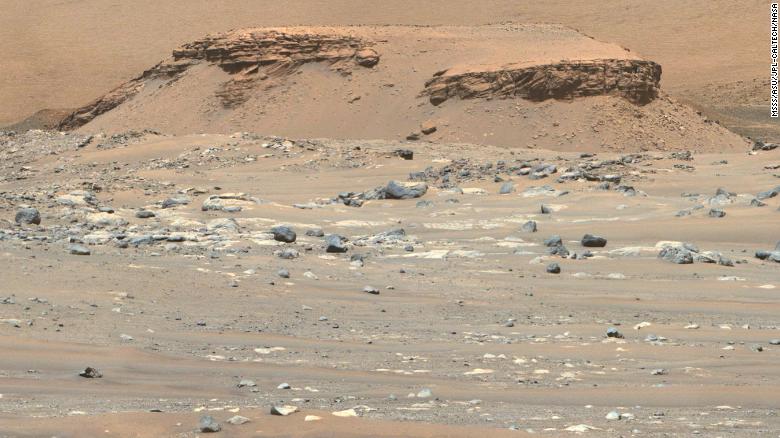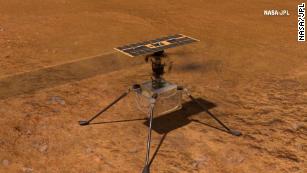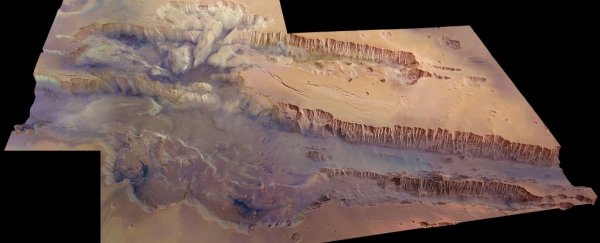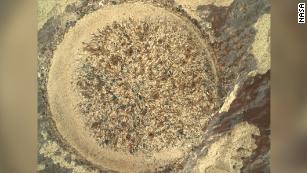Perseverance Mars rover makes surprising discoveries

Scientists with NASA's Perseverance Mars rover mission have discovered that the bedrock their six-wheeled explorer has been driving on since landing in February likely formed from red-hot magma. The discovery has implications for understanding and accurately dating critical events in the history of Jezero Crater—as well as the rest of the planet.
The team has also concluded that rocks in the crater have interacted with water multiple times over the eons and that some contain organic molecules.
These and other findings were presented today during a news briefing at the American Geophysical Union fall science meeting in New Orleans.
Even before Perseverance touched down on Mars, the mission's science team had wondered about the origin of the rocks in the area. Were they sedimentary—the compressed accumulation of mineral particles possibly carried to the location by an ancient river system? Or where they igneous, possibly born in lava flows rising to the surface from a now long-extinct Martian volcano?
"I was beginning to despair we would never find the answer," said Perseverance Project Scientist Ken Farley of Caltech in Pasadena. "But then our PIXL instrument got a good look at the abraded patch of a rock from the area nicknamed "South Séítah," and it all became clear: The crystals within the rock provided the smoking gun."
The drill at the end of Perseverance's robotic arm can abrade, or grind, rock surfaces to allow other instruments such as PIXL to study them. Short for Planetary Instrument for X-ray Lithochemistry, PIXL uses X-ray fluorescence to map the elemental composition of rocks. On Nov. 12, PIXL analyzed a South Séítah rock the science team had chosen to take a core sample from using the rover's drill. The PIXL data showed the rock, nicknamed "Brac," to be composed of an unusual abundance of large olivine crystals engulfed in pyroxene crystals.
"A good geology student will tell you that such a texture indicates the rock formed when crystals grew and settled in a slowly cooling magma—for example a thick lava flow, lava lake, or magma chamber," said Farley. "The rock was then altered by water several times, making it a treasure trove that will allow future scientists to date events in Jezero, better understand the period in which water was more common on its surface, and reveal the early history of the planet. Mars Sample Return is going to have great stuff to choose from."
The multi-mission Mars Sample Return campaign began with Perseverance, which is collecting Martian rock samples in search of ancient microscopic life. Of Perseverance's 43 sample tubes, six have been sealed to date—four with rock cores, one with Martian atmosphere, and one that contained "witness" material to observe any contamination the rover might have brought from Earth. Mars Sample Return seeks to bring select tubes back to Earth, where generations of scientists will be able to study them with powerful lab equipment far too large to send to Mars.
Still to be determined is whether the olivine-rich rock formed in a thick lava lake cooling on the surface or in a subterranean chamber that was later exposed by erosion.
Organic molecules
Also great news for Mars Sample Return is the discovery of organic compounds by the SHERLOC (Scanning Habitable Environments with Raman & Luminescence for Organics & Chemicals) instrument. The carbon-containing molecules are not only in the interiors of abraded rocks SHERLOC analyzed, but in the dust on non-abraded rock.
Confirmation of organics is not a confirmation that life once existed in Jezero and left telltale signs (biosignatures). There are both biological and non-biological mechanisms that create organics.
"Curiosity also discovered organics at its landing site within Gale Crater," said Luther Beegle, SHERLOC principal investigator at NASA's Jet Propulsion Laboratory in Southern California. "What SHERLOC adds to the story is its capability to map the spatial distribution of organics inside rocks and relate those organics to minerals found there. This helps us understand the environment in which the organics formed. More analysis needs to be done to determine the method of production for the identified organics."
The preservation of organics inside ancient rocks—regardless of origin—at both Gale and Jezero Craters does mean that potential biosignatures (signs of life, whether past or present) could be preserved, too. "This is a question that may not be solved until the samples are returned to Earth, but the preservation of organics is very exciting. When these samples are returned to Earth, they will be a source of scientific inquiry and discovery for many years," Beegle said.

'Radargram'
Along with its rock-core sampling capabilities, Perseverance has brought the first ground-penetrating radar to the surface of Mars. RIMFAX (Radar Imager for Mars' Subsurface Experiment) creates a "radargram" of subsurface features up to about 33 feet (10 meters) deep. Data for this first released radargram was collected as the rover drove across a ridgeline from the "Crater Floor Fractured Rough" geologic unit into the Séítah geologic unit.
The ridgeline has multiple rock formations with a visible downward tilt. With RIMFAX data, Perseverance scientists now know that these angled rock layers continue at the same angle well below the surface. The radargram also shows the Séítah rock layers project below those of Crater Floor Fractured Rough. The results further confirm the science team's belief that the creation of Séítah preceded Crater Floor Fractured Rough. The ability to observe geologic features even below the surface adds a new dimension to the team's geologic mapping capabilities at Mars.Rocks on floor of Jezero Crater, Mars, show signs of sustained interactions with water
More information: For more about Perseverance: mars.nasa.gov/mars2020/ and nasa.gov/perseverance
Provided by Jet Propulsion Laboratory
Perseverance rover makes 'completely unexpected' volcanic discovery on Mars
By Ashley Strickland, CNN
Wed December 15, 2021
(CNN)
The Perseverance rover landed on the planet just 10 months ago, but it has already made that surprising discovery.
The rover's latest finding suggests that the bedrock it has been driving over since landing was once formed by volcanic lava flows -- something that was "completely unexpected," according to mission scientists. Previously, they thought the layered rocks Perseverance took photos of were sedimentary.
The rocks that Perseverance has sampled so far also revealed that they interacted with water multiple times, and some of them include organic molecules.
These discoveries could help scientists create an accurate timeline for the events that have taken place in Jezero Crater, the site of an ancient lake, and has wider implications for understanding Mars.
The finding was announced Wednesday during the American Geophysical Union Fall Meeting in New Orleans.
For years, scientists have questioned if the rock in this crater was sedimentary rock, comprised of layers of material deposited by an ancient river, or igneous rock, which forms when lava flows cool.

Perseverance took this photo of Jezero Crater in April. The flat-topped hill, named Kodiak, has ancient layered rocks.
"I was beginning to despair we would never find the answer," said Ken Farley, Perseverance project scientist at the California Institute of Technology in Pasadena, California, in a statement.
Everything changed when Perseverance began using a drill on the end of its robotic arm to scrape away at the surfaces of rocks.
"The crystals within the rock provided the smoking gun," Farley said.
Perseverance is armed with a suite of sophisticated instruments that can image and analyze these scraped rocks, revealing their composition and mineral content. Ones of these instruments is PIXL, or the Planetary Instrument for X-ray Lithochemistry.
In November, Perseverance used its instruments to study a rock, nicknamed "Brac" by the team. The analysis revealed large olivine crystals surrounded by pyroxene crystals, both of which pointed to the fact that the rock came from volcanic lava flows.
"A good geology student will tell you that such a texture indicates the rock formed when crystals grew and settled in a slowly cooling magma -- for example a thick lava flow, lava lake, or magma chamber," Farley said.
"The rock was then altered by water several times, making it a treasure trove that will allow future scientists to date events in Jezero, better understand the period in which water was more common on its surface, and reveal the early history of the planet. Mars Sample Return is going to have great stuff to choose from."
Now, the team wants to know if the rocks containing olivine were formed by a cooling lake of lava, or if they originated from a subsurface chamber of lava that was later exposed due to erosion.
"This was completely unexpected, and we are struggling to understand what it means," Farley said. "But I will speculate that this is not likely the original crater floor. From the diameter of this crater, we expect the original crater floor is significantly deeper than where we are right now."
It's possible that lava flowed down into the crater, he said, but the original crater floor is below the rock they are driving over now.
Bringing back samples
So far, Perseverance has collected four rock samples with plans to collect up to 37 more. These samples will be returned to Earth by future missions, which will enable them to be studied in great detail and a variety of ways. Samples from Jezero Crater and its river delta could reveal if life ever existed on Mars.
Once back on Earth, volcanic rocks can be dated with very high accuracy, so these latest samples could help the team establish more accurate dates for features and events on Mars.
These rocks interacted with water over time to create new minerals. The minerals within the samples can reveal what the climate and environment was like and even the composition of the water billions of years ago on the red planet.

New Perseverance rover images reveal what happened before ancient Martian lake disappeared
"That will tell us whether or not the water that existed there was potentially habitable in the past," said Kelsey Moore, geobiologist and postdoctoral scholar research associate in planetary science at the California Institute of Technology.
The rover also detected organic molecules in the rock it sampled, using its SHERLOC instrument, or Scanning Habitable Environments with Raman & Luminescence for Organics & Chemicals.
The presence of organic molecules doesn't necessarily equal signs of past life, or biosignatures. Organics can be created biologically or abiotically -- a physical process that does not include living organisms.
The Curiosity rover, which landed on Mars in 2012, has also discovered organics within its landing site of Gale Crater. Now that Perseverance has detected them, too, "this helps us understand the environment in which the organics formed," said Luther Beegle, SHERLOC principal investigator at NASA's Jet Propulsion Laboratory in Pasadena, in a statement.
While more investigation is needed to determine how these organic molecules were created, their presence gives the science team hope. That's because it means that signs of past or present life could be preserved on Mars as well, if life ever existed there.

Why we're grateful for the tiny Ingenuity helicopter on Mars
"When these samples are returned to Earth, they will be a source of scientific inquiry and discovery for many years," Beegle said.
And Perseverance has also been using its onboard ground-penetrating radar instrument, the first ever to be tested out on Mars. The Radar Imager for Mars' Subsurface Experiment, or RMFAX, was used to "to peek into the subsurface and determine the structure of a rock under our wheels," said Briony Horgan, associate professor of planetary science at Purdue University and a scientist on the rover mission.
The experiment was used as the rover drove across a ridgeline. The radar data revealed multiple rock formation with a downward tilt, which continue below the surface from the ridgeline itself. Instruments like RIMFAX can help scientists create a better geologic map of Mars to understand its history.
Investigating an ancient river
Perseverance had a banner year in 2021 and it will move on to even more intriguing territory next year: the ancient river delta.
This fan-shaped structure has intrigued scientists for years, and Farley said the rover will arrive at the delta in about six or eight months.
The rocks in the delta are most likely sedimentary, trapping and preserving precious layers of silt from the river that once flowed into the crater's lake. And the samples could reveal if organic molecules associated with signs of life, or even microfossils, could be hiding within the remains of the delta.

A digital terrain model of Valles Marineris. (ESA/DLR/FU Berlin (G. Neukum), CC BY-SA 3.0 IGO)
MICHELLE STARR
16 DECEMBER 2021
A vast system of canyons that dramatically scars the face of Mars could be harboring reserves of hidden water.
An unusually high quantity of hydrogen has been detected in the heart of the 4,000 kilometers (2,485 miles) of canyons known as Valles Marineris, nicknamed the Grand Canyon of Mars. We know this thanks to new data from the ESA-Roscosmos ExoMars Trace Gas Orbiter's FREND instrument.
The finding suggests that, at depths up to a meter (three feet) below the surface, the soil in the region is rich in water, either bound up in minerals or as subsurface water ice, potentially offering a new way of locating the precious stuff on the apparently extremely arid world.
"With the Trace Gas Orbiter, we can look down to one meter below this dusty layer and see what's really going on below Mars's surface – and, crucially, locate water-rich 'oases' that couldn't be detected with previous instruments," said physicist Igor Mitrofanov of the Space Research Institute of the Russian Academy of Sciences in Russia; lead author of the new study.
"FREND revealed an area with an unusually large amount of hydrogen in the colossal Valles Marineris canyon system: Assuming the hydrogen we see is bound into water molecules, as much as 40 percent of the near-surface material in this region appears to be water."
We know there's water on Mars. We can see it, at the cold poles, bound up as ice. That's where most of it seems to be; at the equator, conditions are too warm for water ice to form at the surface.
It's possible that water can be found under the surface, but other previous searches by other Mars satellites only found it at higher latitudes.
Cue FREND, or the Fine Resolution Epithermal Neutron Detector. Rather than mapping light at the very surface of the red planet, FREND detects neutrons. This allows it to see the hydrogen content of Mars's soil up to a meter below the surface, the researchers said. Which, in observations taken between May 2018 and February 2021, it seems to have done.
"Neutrons are produced when highly energetic particles known as galactic cosmic rays strike Mars; drier soils emit more neutrons than wetter ones, and so we can deduce how much water is in a soil by looking at the neutrons it emits," said physicist Alexey Malakhov, also of the Space Research Institute of the Russian Academy of Sciences.
"We found a central part of Valles Marineris to be packed full of water – far more water than we expected. This is very much like Earth's permafrost regions, where water ice permanently persists under dry soil because of the constant low temperatures."

The high-hydrogen region is about the size of the Netherlands, and overlaps with Candor Chasma, one of the largest canyons in the Valles Marineris system. In this region of Mars, minerals typically contain very little water, so the researchers believe the substance is likely in the form of water ice below the surface.
But how that water could persist there is a mystery. Pressure and temperature conditions at the Mars equator ought to prohibit the formation of such water reserves. There may be some unknown combination of geomorphological conditions in Valles Marineris that allows it, such as patchy isolated deposits that have been there for some time, or the angle and orientation of steep slopes.
Further investigation will be needed to work out exactly what is going on – not just the conditions that allow for equatorial water on Mars, but to confirm what form that water takes. Doing so could be deeply rewarding: stores of water in a permafrost-like form may, just as we have found right here on Earth, have preserved frozen fragments of microbial life, or organic molecules that once existed on Mars.
The discovery also represents exciting possibilities for Mars exploration. Any crewed Mars mission is likely to set down near the equator; water that might be found not far beneath the surface would be an amazing asset, both for exploration purposes, and for the vital task of keeping water-reliant humans alive.
And, of course, it makes scientists even more keen to visit the unusual and fascinating Valles Marineris – the largest canyon in our Solar System.
"This result really demonstrates the success of the joint ESA-Roscosmos ExoMars programme," said physicist Colin Wilson of the European Space Agency.
"Knowing more about how and where water exists on present-day Mars is essential to understand what happened to Mars's once-abundant water, and helps our search for habitable environments, possible signs of past life, and organic materials from Mars's earliest days."
The team's research has been published in Icarus.
Scientists Just Found a 'Significant' Volume of Water Inside Mars' Grand Canyon
And it's 'packed full of water'.
The Red Planet is hiding an appealing secret.
Scientists have discovered a world-historic discovery on Mars: "significant amounts of water" are hiding inside the Red Planet's Valles Marineris, its version of our grand canyon system, according to a recent press release from the European Space Agency (ESA).
And up to 40% of material near the surface of the canyon could be water molecules.
Mars' Valles Marineris canyon system is hiding water
The newly discovered volume of water is hiding under the surface of Mars, and was detected by the Trace Gas Orbiter, a mission in its first stage under the guidance of the ESA-Roscosmos project dubbed ExoMars. Signs of water were picked up by the orbiter's Fine Resolution Epithermal Neutron Detector (FREND) instrument, which is designed to survey the Red Planet's landscape and map the presence and concentration of hydrogen hiding in Mars' soil. It works like this: while high-energy cosmic rays plunge into the surface, the soil emits neutrons. And wet soil emits fewer neutrons than dry soil, which enables scientists to analyze and assess the water content of soil, hidden beneath its ancient surface. "FREND revealed an area with an unusually large amount of hydrogen in the colossal Valles Marineris canyon system: assuming the hydrogen we see is bound into water molecules, as much as 40% of the near-surface material in this region appears to be water," said Igor Mitrofanov, the Russian Academy of Science's lead investigator of the Space Research Institute, in the ESA press release.
Scientists have already discovered water on Mars, but most earlier discoveries detected the substance crucial to life as we know it near the poles of the Red Planet, subsisting as ice. Only very small pockets of water had shown up at lower latitudes, which was a big downer because future astronauts on Mars will need a lot of water, and there are better prospects for settling the planet at lower latitudes. But now, with what seems like a comparative abundance of water in Valles Marineris, we've taken a major step toward establishing a reliable source of water on the closest alien world.
Mars' canyon water could be liquid, ice, or a messy mix
"The reservoir is large, not too deep below ground, & could be easily exploitable for future explorers," read a tweet on the announcement from ExoMars. That sounds basically great! But it's too soon for Musk to pack up his bags and fly to the site, since much work is left to be done. A study accompanying the announcement, published in the journal Icarus, shows that neutron detection doesn't distinguish between ice and water molecules. This means geochemists need to enter the scientific fray to reveal more details. But several features of the canyon, including its topology, have led the researchers to speculate that the water is probably in solid form (ice). But it could also be a mixture of solid and liquid.
"We found a central part of Valles Marineris to be packed full of water — far more water than we expected," said Alexey Malakhov, co-author of the study, in the ESA release. "This is very much like Earth's permafrost regions, where water ice permanently persists under dry soil because of the constant low temperatures." So while we don't yet know the specific form of water is lying under Mars' vast system of canyons, the first human mission to Mars may consider exploring this area a major priority.
This was a breaking story and was regularly updated as new information became available.


No comments:
Post a Comment